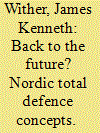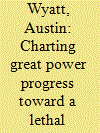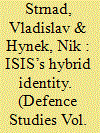| Srl | Item |
| 1 |
ID:
171141


|
|
|
|
|
| Summary/Abstract |
Russia’s aggression against Ukraine has forced the greatest a re-appraisal of European security since the end of the Cold War. In the Nordic region, this has led to preparations for great power armed conflict in the region after a long period of strategic neglect. All three of the Nordic states examined here, Finland, Sweden and Norway, have adopted so called total defence policies. Total defence combines the armed forces and civil society in a comprehensive whole of society approach to security intended to deter an attack by making a target state a very challenging prospect for an aggressor. Finland retained a total defence policy after the Cold War, but has had to re-examine its utility for the contemporary threat environment. For Norway and Sweden, total defence means significant challenges reviving Cold War era planning in a very different security and societal context. This study examines current Nordic security concepts through the critical, elements of total defence policies: national resilience and territorial defence. It also addresses the role that alliances and partnerships play in contemporary Nordic total defence planning. An important question is the extent to which these total defence concepts effectively address the perceived political and military threat from Russia.
|
|
|
|
|
|
|
|
|
|
|
|
|
|
|
|
| 2 |
ID:
171138


|
|
|
|
|
| Summary/Abstract |
The emergence of Lethal Autonomous Weapon Systems (LAWS) offers a comparatively low adoption-cost strategy to emerging great powers that would allow them to offset the conventional military advantage enjoyed by their rivals, which threatens the established global balance of power. This article critically analyses the role of China and the United States in the development of the “hardware” and “software” components of LAWS, concluding that, while the demonstration point has not yet been reached, the incubation of this emerging revolution in military affairs has already begun to have a geopolitical impact.
|
|
|
|
|
|
|
|
|
|
|
|
|
|
|
|
| 3 |
ID:
171142


|
|
|
|
|
| Summary/Abstract |
This paper analyses the means, degree, and strategic significance of the Islamic State’s (ISIS) self-representation simultaneously as a state-like entity and a terrorist organisation. We explore how ISIS strategically used the content of its propagandist magazine Dabiq to spin its dual – or hybrid – identity, with the aim of broadening its propagandist reach. ISIS’s discursive crossfading between an aspiring, state-like territorial actor and a networked, terrorist group was the central part of its ability to mesmerise multiple audiences simultaneously. The hybrid self-representation is first contextualised vis-à-vis existing academic analyses of ISIS’s magazine Dabiq and its depiction of ISIS. Then we discuss our original thematic analysis of ISIS’s narrative features and dynamics across all existing Dabiq issues. Through abduction, we identified six themes: three presenting ISIS as a state and three as a terrorist organisation. Subsequent triangulation of these themes offers a novel contribution to the academic literature and allows us to show how ISIS attempted to maintain a state-like image to increase its radicalisation potential.
|
|
|
|
|
|
|
|
|
|
|
|
|
|
|
|
| 4 |
ID:
171140


|
|
|
|
|
| Summary/Abstract |
Peace operations of the United Nations (UN) have changed significantly since the 1990s. The turn towards “stabilisation” operations increasingly allows the use of military force against armed groups. For some troop contributing armies, this means that peacekeeping has become the first occasion on which soldiers gain combat experience. Yet, what are the consequences of this development for eventual internal public security roles of armed forces? Contributing to discussions on conditions for organisational change, this article develops a model for blending the analysis of bottom-up adaptation and top-down military innovation with studies on civil-military relations. This model is used for examining military learning that resulted from the reciprocal relationship between the Brazilian military’s internal “Guaranteeing Law and Order” (GLO) operations and coercive operations against urban crime groups during the UN Stabilisation Mission in Haiti (MINUSTAH). The article finds that a complex interplay between bottom-up adaptation and top-down innovation – enabled by politicians who supported the transfer of lessons – led to a process in which internal missions and peacekeeping deployments mutually informed military change. Soldiers’ adaptation to coercive operations, changes in the legal framework for internal missions, and the development of appropriate doctrine for urban operations resulted in the institutionalisation of military learning.
|
|
|
|
|
|
|
|
|
|
|
|
|
|
|
|
| 5 |
ID:
171139


|
|
|
|
|
| Summary/Abstract |
The annexation of Crimea and the Russia enabled rebellion in Donbas created a need for radical improvements of Ukrainian military capability. This study discusses how different, mostly domestic, reform drivers and reform impeding factors had impact on the pace of Ukrainian top-down defence reform in the period since the confrontation with Russia started in 2014. It concludes that reform has been uneven, and that while vested organizational interests and dominant organizational ideas explain much of the slowness of reform, also corruption played a significant role. Furthermore, the Ukrainian case demonstrates how foreign pressure was important to facilitate reform even in a country that found itself facing the danger of major war. Nevertheless, the study does confirm previous findings that a “threat of defeat in war” in the end overcome domestic restraints to defence reform.
|
|
|
|
|
|
|
|
|
|
|
|
|
|
|
|